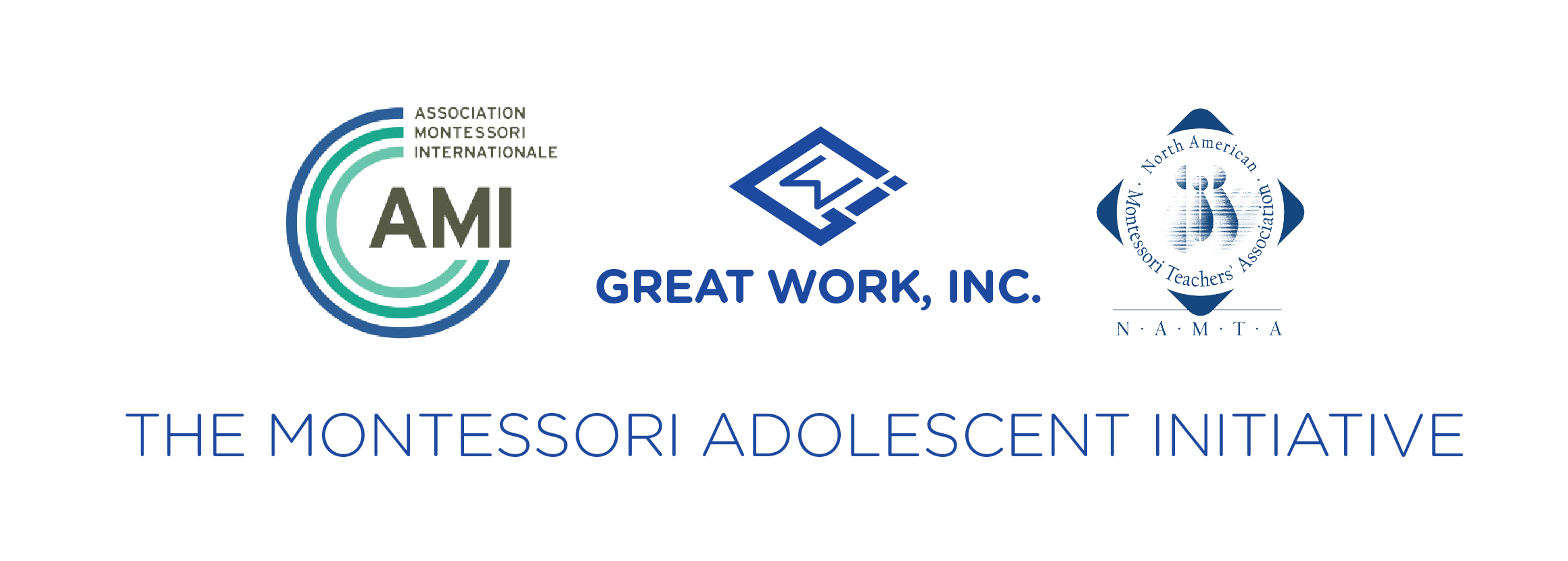Deep Dive on Characteristics of the Adolescent
Deep Dive Summary: Scientific Observation
Submitted by Michael Waski
We started off by grappling with what we meant by “characteristics” and how these were linked to the idea of a need. Characteristics describe who the adolescent is. They are universal and timeless, unchangeable, given from nature, and they assist in development and allow us to adapt to our environment. The needs are the driving force (requirements?PM) which allow them to develop and adapt to their environment properly. Therefore, the needs and characteristics are intrinsically linked.
We spent a good deal of time looking over Montessori’s writings and seeing who she said the adolescent was physically, psychologically, and socially. We then discussed our observations, being careful to try to not misidentify behaviors resulting from needs not being met (lethargy, depression, etc.) for true characteristics. We also tried to not limit our thinking to what we may see in a specific environment, but tried to understand the true nature of the adolescent.
The following table is a summary of what we have discussed, with some of our supporting quotes from Montessori below.
Physical Developmental Characteristics:
· Rapid physical change
· Tremendous growth e.g. longer limbs
· Coordination challenges (less graceful)
· Sexual maturation
· Hormonal changes (e.g. more body odour)
· Boundless energy <-> lethargy
· Fatigue/decreased stamina
· Changes in sleep patterns/need for more uninterrupted sleep
· Vulnerability to physical damage
· Susceptibility to (mental or physical) unwellness
Physical Developmental Needs:
· Regular movement
· Physical activity to practice using growing body
· Movement to challenge strength and coordination
· Understanding and self-awareness of physical and sexual changes
· Rest and relaxation
· Healthful diet and sleeping habits
· Manual work
· Necessary and sufficient (only) protection
Psychological Developmental Characteristics:
· Rapid psychological change
· Decrease in cognitive concentration
· Developing critical thinking
· Capable of mature thought (if framed in a personal context)
· Creatively expressive
· Increased impulsivity
· Increased risk taking
· Egocentricity
· Developing self-awareness (insecurity and self-criticism)
· Concern with personal dignity
· Alertness to social injustice (as righteousness > taking practical action)
· Emotional unevenness e.g. optimism <-> despair
Psychological Developmental Needs:
· Adult models
· Supportive relationships with peers and adults
· Connection to place and nature
· Contemplation and reflection (meditation)
· Solitude (as well as society)
· Personal dignity
· Psychological safety
· Experience of the value of meaningful work
· Valorisation (through contribution)
· Creative expression of thoughts and emotions
· Understanding and self-awareness of habits of mind
· Skills of self-sufficiency
· Increasing independence and adaptability
· Economic exchange
· Moral experience and ‘grappling’
· Necessary and sufficient (only) protection
Social Developmental Characteristics:
· Interplay between personal and social identity
· Humanistic – observant of and seeking to understand human behaviour
· Alertness to flaws and hypocrisy
· Distancing from family
· Identifying with and belonging to group(s)
· Solidarity with/loyalty to peers
· Sensitivity to views of others
· Questioning of bounds and norms
· Developing (exercising) capability and contribution
· Developing social and economic independence
· Seeking service and purpose/longing for place in society
Social Developmental Needs:
· Experience in building and maintaining a community (social organisation)
· Variety of adults and adult relationships as models
· Contribution (social/economic)
· Collective work
· Glimpses of future self (purpose, vision)
· Necessary and sufficient (only) protection
Supporting original source quotes:
Life in the open air, in the sunshine, and a diet high in nutritional content coming from the produce of neighbouring fields improve the physical health, while the calm surroundings, the silence, the wonders of nature satisfy the need of the adolescent mind for reflection and meditation. (From Childhood to Adolescence, CLIO p. 67)
If puberty is on the physical side a transition from an infantile to an adult state, there is also, on the psychological side, a transition from the child who has to live in a family, to the man who has to live in society . These two needs of the adolescent: for protection during the time of the difficult physical transition, and for an understanding of the society which he is about to enter to play his part as a man. (From Childhood to Adolescence, CLIO p. 60)
These very children reveal to us the most vital need of their development, saying : 'Help me to do it alone!' (From Childhood to Adolescence, CLIO p. 67)
Productive work and a wage that gives economic independence, or rather constitutes a first real attempt to achieve economic independence, could be made with advantage a general principle of social education for adolescents and young people. (From Childhood to Adolescence, CLIO p. 66)
Independence, in the case of the adolescents, has to be acquired on a different plane, for theirs is the economic independence in the field of society. Here, too, the principle of "Help me to do it alone!" ought to be applied. (From Childhood to Adolescence, CLIO p. 67)
From the psychological viewpoint also this is a critical age. There are doubts and hesitations, violent emotions, discouragement and an unexpected decrease of intellectual capacity. The difficulty of studying with concentration is not sue to a lack of willingness, but is really a psychological characteristic of the age...The chief symptom of adolescence is a state of expectation, a tendency towards creative work and a need for the strengthening of self-confidence. (From Childhood to Adolescence, CLIO p. 63)
These defects may have very dangerous results, either for the future of the individual (timidity, anxiety, depression, inferiority complex), or for society (incapacity to work, laziness, dependence on others, or cynicism and criminality. (From Childhood to Adolescence, CLIO p. 63)
We also read heavily from Development and Education of the Adolescent: Essay from Kodaikanal and feel this is also a fantastic resource of insight into the chracteristics of the adolescent.
